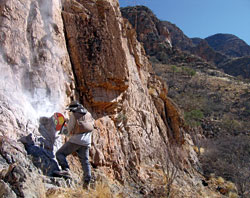 |
 Enlarge image
Enlarge image |
| Geochemist Bernhard Peucker-Ehrenbrink collects samples of 635-million-year-old rock in Namibia, to study the iridium layer for evidence of snowball earth vs. slushball earth. |
In the 1990s, an enigmatic series of rock formations, found
all over the world, led scientists to the provocative and
controversial Snowball Earth theory: Between 2.2 billion and
635 million years ago, Earth’s climate swung violently
between freeze and fry modes. The planet was either covered
by ice from pole to pole, including a thick blanket shrouding
all its oceans, or it thawed into a hothouse because of a
buildup of heat-trapping greenhouse gases.
The theory offers insights into the evolution of our planet,
its climate—and also life on Earth. After the last Snowball
Earth melted, complex life-forms blossomed on a planet previously
populated with nothing but single-celled organisms.
A variation of the theory arose—Slushball Earth—in
which most oceans froze but a band of ice-free or thin-ice
waters remained around the equator, providing marine organisms
with open water and light to survive.
Key evidence for the theory are glacially derived rock formations
that lie immediately below rocks that formed in tropical oceans.
In the thin inter-layer boundary, unusually high concentrations
of iridium, a noble metal, have been detected. Some scientists
theorize that it came from space, landed on ice, and was stored
there until it was deposited in a gush when Snowball Earth
glaciers melted. Alternatively, the iridium may derive from
volcanic exhalations, coming from the Earth’s mantle.
In 2005, WHOI geochemist Bernhard Peucker-Ehrenbrink (left)
collected samples of 635-million-year-old rocks from the iridium
boundary in the Hoanib Valley in Namibia. He will determine
whether the iridium layer also contains minute quantities
of other noble metals—osmium, rhodium, ruthenium, platinum,
and palladium—that should also be found at high concentrations
if the iridium reflects an accumulation of extraterrestrial
material. With WHOI geochemist Mark Kurz, he will also analyze
the rocks’ osmium and helium isotopic compositions,
two of the most sensitive indicators of extraterrestrial material
on Earth. If the source of the iridium and other noble metals
proves to be purely extraterrestrial, Snowball Earth is a
more likely scenario than Slushball Earth.
—Lonny Lippsett
» View more
highlights for the Marine Chemistry and Geochemistry Department
|

